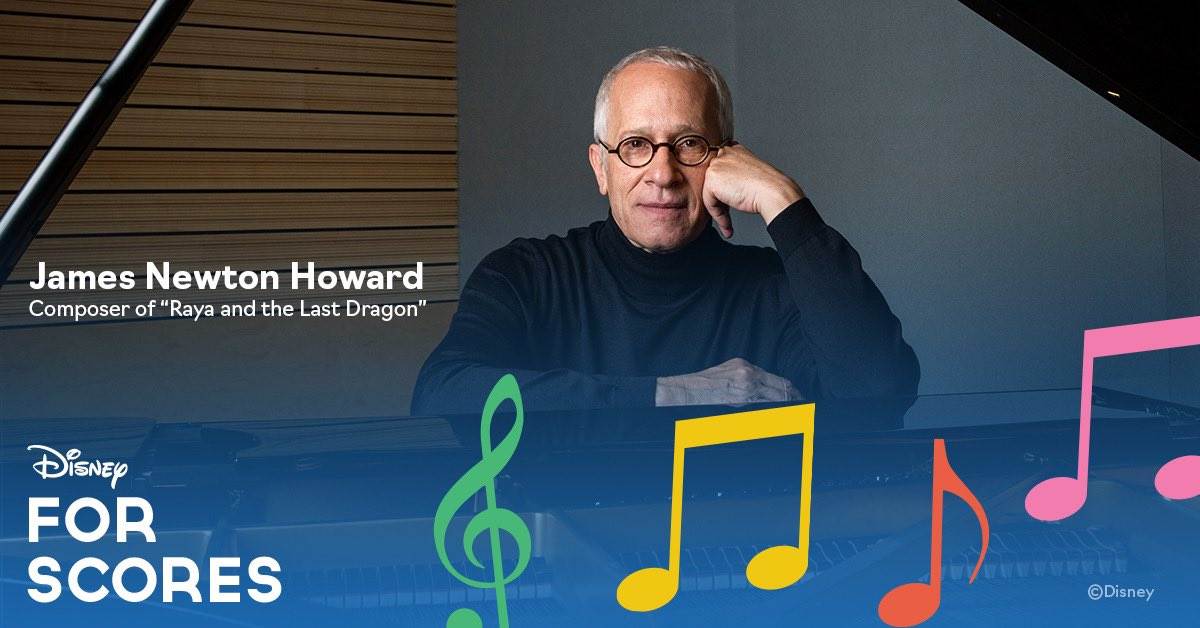James Newton Howard Talks About Scoring Disney’s “Raya and the Last Dragon” and “The Jungle Cruise” in New “For Scores” Podcast Episode
John Burlingame is back with a new episode of Disney’s For Scores podcast with special guest James Newton Howard, who most recently provided the score for Walt Disney Animation Studios’ Raya and the Last Dragon. Throughout the 30-minute interview, he talks about his earliest Disney influences, why he’s so proud of his work on Raya, and what Disney music fans can expect from his work on The Jungle Cruise.
As a child in the 1950’s, James Newton Howard remembers seeing Snow White and the Seven Dwarfs and Pinocchio, both of which had an influence on his musical tastes. He also revealed himself to have been a fan of The Mickey Mouse Club with a crush on Annette Funicello.
Having worked with Walt Disney Animation Studios on Dinosaur, Atlantis: The Lost Empire and Treasure Planet, the composer shared that he was yearning to do another Disney animated feature. While the principals of scoring for live-action and animation are similar, he shared that you can do anything in animation. He also confessed to having a silly personality and loving the opportunity to get zany with animated scores.
Set in Kumandra, a world inspired by Southeast Asian cultures, James Newton Howard got to work researching the music of the regions. “I knew it couldn’t be just a traditional orchestral score, there had to be flutes and gongs and plucked instruments,” he says in the episode. The incorporation of instruments unique to the regions provided an exciting opportunity to make a score that could be easily distinguished from his past work.
Coming on board the project in November 2019, he shared that what he was presented with was a mix of storyboards, rough animation, and character sketches. “Somehow or another, you get used to it and you find yourself becoming moved by a couple of static drawings of the characters if the music is working.” The first theme he wrote for the film, “Running on Raindrops,” ended up becoming one of the main themes for the movie.
In the episode, he discusses how difficult it was to create the 5-minute montage prologue, which had to not only convey many of the themes in the film, but also set the tone. “One of the instruments I used right at the top was sort of a Balinese jaw harp, it’s called a genggong,” he shared. Vocals also became a signature part of the score, with a New York-based singer named Loire providing the war chants and vocalizing Raya’s warrior spirit.
Story changes paused James Newton Howard’s work, returning in March 2020 just as the pandemic started. The score was recorded in October at Sony when they were allowed to reopen, but restrictions meant that the capacity of the orchestra was limited to 40 players at a time. Each of the musicians were doubled to make it sound bigger than the orchestra was allowed to be.
The percussion is another unique ingredient in the score of Raya and the Last Dragon. Skin drums, hand drums and rattles, rarities in western music, can be found throughout the score. Like with the rest of the orchestra, the musicians were doubled in the mixing to make the section sound bigger. In some cases, James Newton Howard even used some samples his crew put together in the final mix. He shared that a continuous struggle in film composing is finding a unique angle for percussion and he felt like he got to break new ground on this film.
James Newton Howard also provided the score for another Disney film, one that’s been delayed a year, The Jungle Cruise. “I think it’s a great movie, it’s really fun,” he shared about the Dwayne Johnson/Emily Blunt action comedy. “It was really hard, there’s a lot of music in it and a lot of giant music in it.” He describes his score as being influenced by both John Williams’ work on Raiders of the Lost Ark fused with South American influences.
Click here to visit the official For Scores website.

